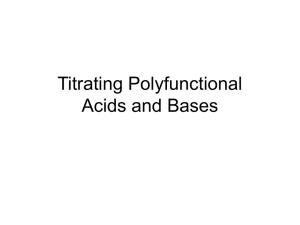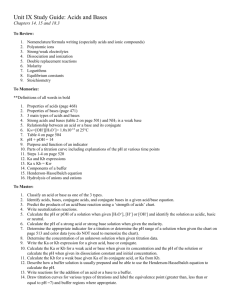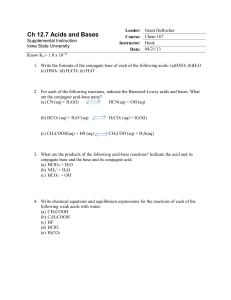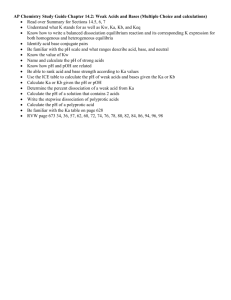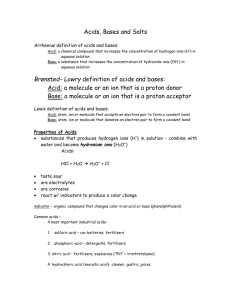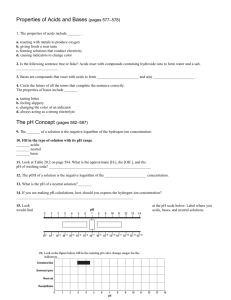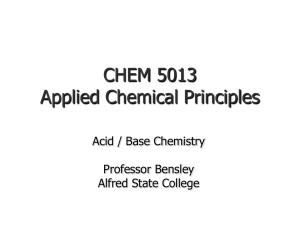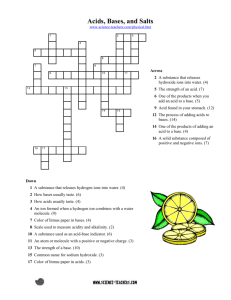Chapter 15. Acids - Bases - Saint Leo University Faculty
advertisement
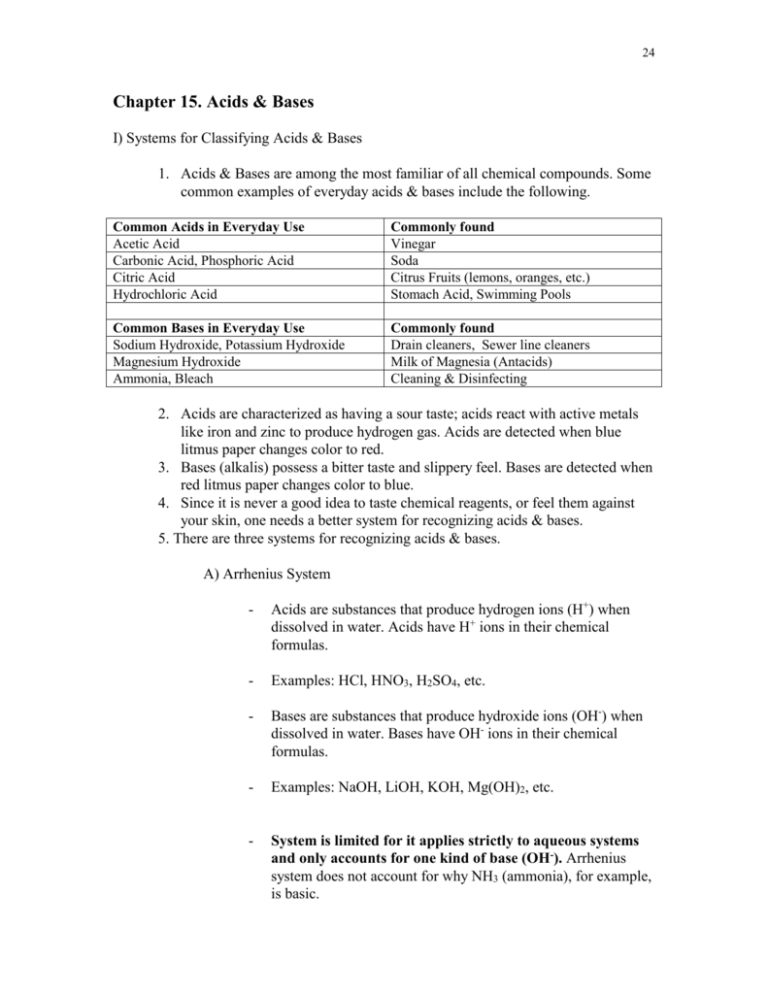
24 Chapter 15. Acids & Bases I) Systems for Classifying Acids & Bases 1. Acids & Bases are among the most familiar of all chemical compounds. Some common examples of everyday acids & bases include the following. Common Acids in Everyday Use Acetic Acid Carbonic Acid, Phosphoric Acid Citric Acid Hydrochloric Acid Commonly found Vinegar Soda Citrus Fruits (lemons, oranges, etc.) Stomach Acid, Swimming Pools Common Bases in Everyday Use Sodium Hydroxide, Potassium Hydroxide Magnesium Hydroxide Ammonia, Bleach Commonly found Drain cleaners, Sewer line cleaners Milk of Magnesia (Antacids) Cleaning & Disinfecting 2. Acids are characterized as having a sour taste; acids react with active metals like iron and zinc to produce hydrogen gas. Acids are detected when blue litmus paper changes color to red. 3. Bases (alkalis) possess a bitter taste and slippery feel. Bases are detected when red litmus paper changes color to blue. 4. Since it is never a good idea to taste chemical reagents, or feel them against your skin, one needs a better system for recognizing acids & bases. 5. There are three systems for recognizing acids & bases. A) Arrhenius System - Acids are substances that produce hydrogen ions (H+) when dissolved in water. Acids have H+ ions in their chemical formulas. - Examples: HCl, HNO3, H2SO4, etc. - Bases are substances that produce hydroxide ions (OH-) when dissolved in water. Bases have OH- ions in their chemical formulas. - Examples: NaOH, LiOH, KOH, Mg(OH)2, etc. - System is limited for it applies strictly to aqueous systems and only accounts for one kind of base (OH-). Arrhenius system does not account for why NH3 (ammonia), for example, is basic. 25 B) Bronsted-Lowry System - Acids are proton (H+) donors; bases are proton (H+) acceptors. - Reaction between acid & base is really a proton transfer reaction, where the products of this reaction can also act as acids or bases. HA + B BH+ + Acid Base Conjugate Acid AConjugate Base - In this system, an acid or base is associated with its corresponding conjugate. A conjugate acid-base pair consists of two substances related to each other by the donating and accepting of a single proton. - Most commonly seen acid & base system in general chemistry. - THE SIXTH AXIOM - Consider the following example: [“Follow the Protons.”] HCl (aq) + H2O (l) H3O+ (aq) Acid Base + Conjugate Acid Cl - (aq) Conjugate Base - Note: H3O+ is called the hydronium ion. [H3O+ H+] - General Reaction for an Acid dissolved in water is represented as follows: HA (aq) + H2O (l) Acid - - H3O+ (aq) + A - (aq) Base Conjugate Conjugate Acid Base Bronsted-Lowry acids and bases include not only electrically neutral species, but also ions. A Bronsted-Lowry base must have at least one unshared pair of electrons in its Lewis structure, so that it can use the lone pair for bonding to the proton. 26 C) Lewis System - A Lewis acid is an electron pair acceptor while a Lewis base is an electron pair donor. - Most generalized system for defining acids & bases, since there are no solvent restrictions. - More about Lewis system in organic chemistry, where it is most often seen. For now, know the definitions for a Lewis acid and Lewis base. II) Acid Strength 1. A strong acid is one that ionizes completely in solution; that means that the value for K is very large. Know the names and chemical formulas for the six strong mineral acids that are commonly found in chemistry. 2. A weak acid is one that ionizes incompletely in solution; that means that the value for K is very small. 3. The direction of reaction to reach equilibrium involves proton transfer from the stronger acid to the stronger base to give the weaker acid and the weaker base. 4. The stronger the acid, the weaker is its conjugate base. The weaker an acid, the stronger is its corresponding conjugate base. 5. Review Figures 15.1-15.5 6. Review Tables 15.1-15.5 III) The Role of Water in Aqueous Acid/Base Chemistry 1. An amphoteric substance is one that can behave either as an acid or a base. 2. Water is the most common example; but this behavior is also found in some liquids that are common solvents (e.g., ammonia, ethanol, etc.). These liquids readily undergo autoionization reactions. Autoionization reactions refer to the ability of a substance to react with itself. 3. For water the autoionization reaction is written as follows: 2 H2O (l) H3O+ (aq) + OH- (aq) 27 K = [H3O+][OH-] / [H2O] But recall that the concentration of a pure liquid or solid is constant, so we can incorporate them into equilibrium expressions. The molar concentration of water [H2O] @ 25 C is 55.3 M, and is a constant. Rearranging terms gives us the following. K [H2O] = [H3O+][OH-] / [H2O] ( [H2O] ) = Kw Therefore, Kw = [H3O+][OH-] = 1.00 x 10-14 @ 25 C where Kw is the ion-product constant or dissociation constant for water. Like its counterpart Kc, Kw is dependent upon temperature and must be specified. 4. One can distinguish acidic, neutral, and basic aqueous solutions by the relative values of the H3O+ and OH- concentrations. [H3O+] > 1.0 x 10-7 M [H3O+] = [OH-] = 1.0 x 10-7 M [H3O+] < 1.0 x 10-7 M Acidic Neutral Basic IV) The pH Scale 1. The logarithmic pH scale allows one to conveniently determine whether a sample is acidic, basic, or neutral. 2. Mathematically pH is defined as follows: pH = - log [ H+ ] [ ] in Molarity units. The relationship between acidic & basic, in aqueous environments, is shown below. pH + pOH = 14.00 3. A solution is acidic if the pH is below 7.0 and basic above pH 7.0. At pH 7.0 a sample has a neutral pH. 4. Review Figure 15.7 & 15.8. 5. Go over Example Problems. 6. Measuring pH in the Laboratory A) Acid-Base Indicators B) pH meter 28 V) Solving Equilibrium pH Problems 1. Writing Equilibrium Expressions for Acid & Base Reactions HA (aq) + H2O (l) H3O+ (aq) + A - (aq) Ka = [H3O+ ][ A - ] / [HA] = [H+][ A - ] / [HA] - Acid dissociation constant (Ka ) is simply an equilibrium constant that differs from K by accounting for the constant concentration of water (a pure liquid). - For reactions involving bases one also has a base dissociation constant (Kb ). 2. Need to be familiar with common strong acids & bases and know definitions for monoprotic acid, polyprotic acid, & organic acids. 3. The Method A) List the major species present in the solution. - Does the reaction involve strong or weak acids (or bases)? If acid or base is weak what is the magnitude of the equilibrium constant (Ka or Kb)? B) Write out the balanced chemical reactions that are taking place along with their corresponding equilibrium expressions. - Acid dissociation reactions denoted by Ka while base dissociation reactions are symbolized by Kb. If multiple reactions are present, decide what reactions are most prevalent in the system by comparing Ka (or Kb) values. Any approximations (i.e., assumptions) that are made must be verified. C) Construct the equilibrium table. D) Substitute the algebraic expressions, obtained from the equilibrium table, into the equilibrium constant expression. E) If any approximations (i.e., assumptions) are made to simplify the math, then do so but remember that all assumptions must be verified as true. F) Solve for the unknown quantity. 29 G) Verify that any assumptions made are valid. VI) Some Examples 1. What is pH of the following solutions? a) 0.250 M NaOH b) 0.250 M Ca(OH)2 c) 0.375 M NH3 Answer = 13.40 Answer = 13.70 Answer = 11.41 VII) Formation of Acids & Bases 1. Nonmetal oxides react with water to form acids. 2. Metal oxides react with water to form bases. 3. Examples VIII) Predicting Acidity, Basicity, Neutrality of Ionic Salts 1. Cation part comes from corresponding base while anion portion comes from the acid. 2. Whichever part is stronger will determine if salt is acidic, or basic. If both parts are equal in strength, then the salt is neutral. 3. Examples
